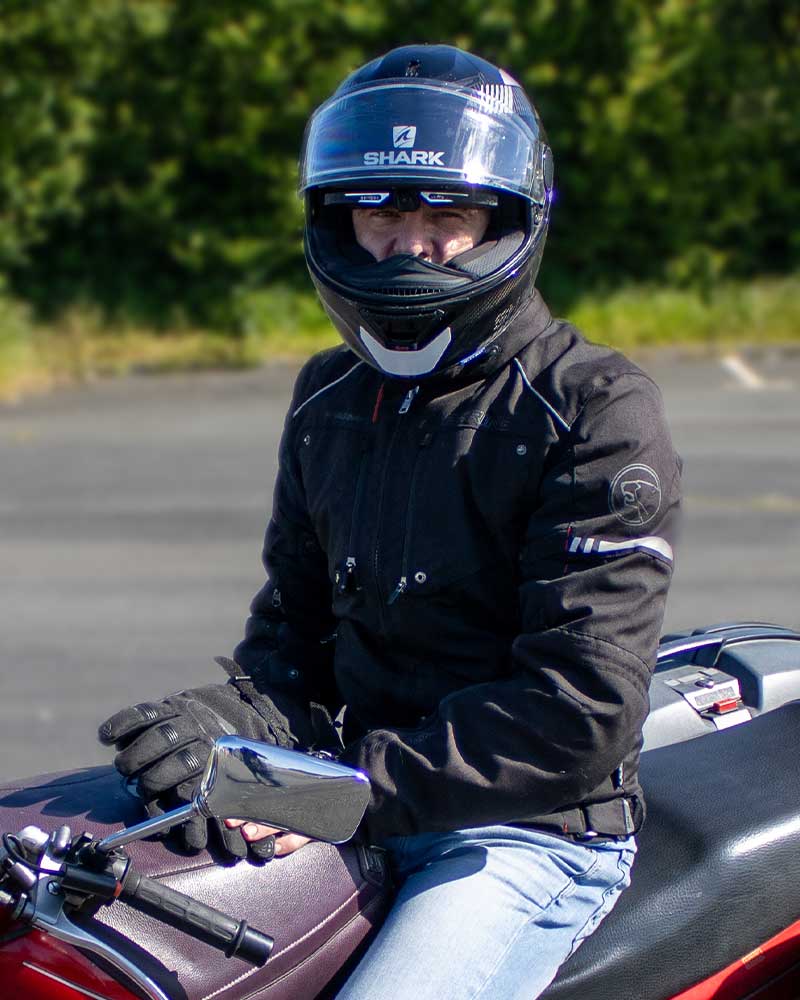August 26, 2024
Reading time : 6 minutes
Urban mobility is undergoing significant change. Faced with traffic jams and everyday well-being challenges, city dwellers are increasingly turning to gentle and eco-friendly modes of transportation, such as bicycles and electric scooters. While these alternatives appeal for their convenience and minimal environmental impact, they are not without risks. Due to the lack of a protective shell, users of two-wheeled vehicles are more vulnerable and face numerous hazards.
It is in this context that helmet cameras emerge as valuable tools to ensure peace of mind during two-wheeled journeys. Serving as impartial witnesses to road events, they :
- Empower the users themselves : it has been shown that wearing an onboard camera positively influences owners’ behaviors on the road, since knowing their actions are recorded encourages responsible usage.
- Deter aggressive behaviors: the mere presence of a camera can prompt other road users to adopt more cautious and respectful driving habits.
- Gather evidence in case of accidents: in case of disputes, footage recorded by the camera can be crucial in determining accountability and seeking compensation.
- Capture memorable moments: beyond its safety benefits, a helmet camera also allows users to capture significant moments from their daily travels, to share with loved ones or to relive later.
Discover in this article how Cambox helmet cameras contribute to making your daily journeys more serene.
Sommaire
Evolution of transportation modes
There has been a transformation in transportation modes for over a decade now, especially in urban areas. Indeed, with the emergence of electric scooters and the immediate success that followed, along with the rise of cycling as a means of commuting, city dwellers are increasingly abandoning cars in favor of these so-called “soft” mobility options.
The rise of cycling as an urban transport mode
Cycling has experienced a significant surge in urban areas. Several factors explain this enthusiasm. On one hand, there is a desire to escape traffic jams that congest cities, representing the most significant time loss for commuters. On the other hand, environmental concerns are pushing more commuters towards eco-friendly modes of transportation. Finally, public policies are encouraging this transition through systematic development of dedicated spaces for cyclists (cycle paths, bike lanes, bike parking), the introduction of bike-sharing schemes, and financial incentives for purchasing electric bikes.
Electric bicycles, in particular, have revolutionized how people perceive cycling. With electric assistance, they allow for longer distances to be covered without excessive effort, making cycling accessible to a broader audience and ensuring riders arrive at work without breaking a sweat, thanks to technology. Consequently, the number of cyclists in cities has significantly increased, reducing dependence on cars and contributing to better air quality.
Some figures to illustrate the popularization of cycling as a daily means of transportation :
- 60% of French people regularly use bicycles for transportation (Source: Ipsos).
- 738,000 electric bicycles were sold in France in 2022 compared to 37,000 in 2011 (Source: Statista).
- 12 million new bicycles were sold in France between 2018 and 2022 (Source: notre-environnement.gouv.fr).
The rapid rise of electric scooters: a next-generation urban mobility
Having only appeared a few years ago, electric scooters have quickly taken over city sidewalks and streets at an impressive pace. Their success lies in their unparalleled convenience: lightweight, foldable, easy to use, and relatively fast depending on the model, they offer a quick and flexible individual mobility solution, particularly suited for commuting in city centers.
The phenomenon of electric scooters was also boosted during the COVID-19 pandemic, as people sought to avoid crowded public transport.
Figures illustrating the success of electric scooters:
- 640,000 electric scooters were sold in France in 2023 compared to 101,000 in 2017 (Source: Statista).
- Over 50% of electric scooter owners use them daily (Source: mobilityurban.fr/).
Do powered two-wheelers still have the same popularity ?
Despite the rise of new forms of eco-friendly mobility, the motorcycle and scooter market continues to maintain its status and show dynamism as of early 2024. In the first quarter, this market saw a 4% increase, driven notably by the secondhand segment which recorded a 6% rise. In 2023, no less than 206,000 new motorcycles and scooters were registered in France. This momentum carries on from previous years. In 2020, the proportion of French households equipped with at least one two-wheeled vehicle was estimated at 8.3% according to the National Interministerial Road Safety Observatory. This positive trend is also reflected on a European scale, with an 8% increase in motorcycle and scooter registrations between 2020 and 2021, according to ACEM.
In urban environments, motorised two-wheelers remain relevant due to their easy handling and compact size, allowing them to navigate through traffic and save considerable time by avoiding congestion. Additionally, in city centers where parking is scarce and expensive, two-wheelers have no equal in terms of easy parking almost anywhere.
The electric revolution is also reaching the two-wheeled category, making it environmentally friendly in addition to its many other advantages. This new segment is thus experiencing a logical success. This trend is expected to continue according to studies such as those by Global Market Insights , estimating a market size of $60 billion by 2032 (up from $35 billion in 2023).
Complementary means of transportation for smoother urban mobility
Bicycles represent an ideal mode of transport for short to medium urban trips, offering a healthy, eco-friendly, and economical alternative to cars. Electric scooters, on the other hand, are perfect for “last-mile” travel, allowing users to quickly and easily connect from their bus or metro stop to their final destination. Finally, motorized vehicles naturally enable higher speeds, making these two-wheelers versatile and efficient in city centers, on highways, and even outside urban areas.
This evolution in transportation modes does present new challenges, particularly in terms of road safety and the coexistence of different road users.
2- MORE VULNERABLE USERS
Bicycles, scooters, and other motorized two-wheelers invigorate urban mobility, but users of these modes of transport remain vulnerable commuters. Faced with heavy urban traffic and uncivil or even dangerous behavior from other road users, they are more exposed to accidents and assaults. Ensuring the safety of these increasingly numerous users has thus become a major challenge.
An increased vulnerability to road accidents
According to road safety statistics, in 2020, motorized two-wheelers accounted for only 2% of traffic but made up 34% of serious road injuries. In city centers, two-wheelers are the most prone to road accidents. For instance, in the French capital Paris, 58% of bodily injury accident victims (minor injuries, serious injuries, deaths) were two-wheeler users (motorcyclists, scooter riders, e-scooter riders, cyclists) (source: cdn.paris.fr).
Cyclists are particularly affected, and while the number of road injuries has tended to decrease, the number of seriously injured cyclists has continuously increased (+14% in 2022 compared to 2021). This figure is, of course, correlated with the widespread use of bicycles.
This can be explained by several more or less obvious reasons. Firstly, the absence of a body shell, directly exposing their bodies to impacts, results in more injuries. Secondly, two-wheelers, by their very nature, are more prone to falls due to their instability. For example, when the ground is wet, the risk of slipping and falling increases. Finally, the fact that they are smaller than four-wheeled vehicles makes them less visible, often in blind spots, and thus more likely to be hit by inattentive drivers.
Risky Behaviors on the Road
Users of two-wheeled vehicles are particularly exposed to irresponsible actions by drivers. Speeding, using a phone while driving, and not respecting safe distances are risky behaviors that increase the number of accidents. According to an Ipsos survey, 96% of road users are concerned about the risky conducts of other drivers. On the other hand, according to the same survey, 66% of drivers admit to using their phones while driving, and perhaps even more alarming, 84% of those surveyed admit to occasionally taking their eyes off the road for two seconds (equivalent to covering 70 meters at 130 km/h). Finally, drivers who do not respect safe distances, cut across lanes, or refuse to yield to two-wheeled vehicles engage in dangerous behaviors that can lead to accidents.
The road, a breeding ground for aggressiveness
Incivility and aggressiveness from other drivers are also sources of danger for two-wheeled vehicle users. They are indeed vulnerable to verbal or physical assaults from other road users. According to the Vinci Barometer, 89% of French drivers even admit to fearing aggressive behavior from others, and 80% express concerns about their safety due to this phenomenon. Insults, fights, and sometimes deliberate collisions – road violence can quickly escalate. 20% of drivers surveyed even admit to getting out of their vehicle to confront another driver, a figure that is steadily increasing (Ipsos survey).
“These are people who can be perfectly responsible, in control of themselves at work, at home […] but behind the wheel, they become out of control.” – Jean-Yves LAMANT, President of the League Against Road Violence. According to him, the proliferation of transportation modes leading to a reduction in urban space reserved for cars is partly responsible for the increase in such behaviors
THE DEMOCRATIZATION OF THE USE OF DASHCAMS AND ONBOARD CAMERAS
Faced with the increasing risks and dangers associated with two-wheeled travel, users are increasingly turning to onboard cameras, or “dashcams,” to protect themselves and defend their rights in the event of an accident or assault. The market is expected to double by 2029 (source: www.mordorintelligence.com).
Impartial witnesses for contentious situations
Cameras, installed on helmets or car dashboards, continuously record events occurring on the road. In the event of an accident or assault, the recorded footage can be crucial for:
- Determining liability: The footage allows for precise reconstruction of events and identification of the party responsible for the accident or assault.
- Facilitating insurance claims: The footage can be submitted to the insurance company to expedite the compensation process and avoid disputes.
- Filing a complaint and obtaining justice: In the case of an assault, the footage can serve as evidence to support a complaint and help identify and prosecute the assailant.
A deterrent against aggressive behavior
The mere presence of a dashcam on a helmet or vehicle can have a deterrent effect on the aggressive conduct of other road users. Indeed, knowing that their actions are being recorded, they are less likely to risk being identified and prosecuted if they commit an act of incivility or reprehensible behavior.
An equipment that promotes responsibility
Beyond their practical aspect in case of disputes, dashcams can also help improve road safety by encouraging users to adopt more cautious and respectful behaviors. Indeed, knowing that their actions are being recorded prompts the owners of onboard cameras to drive more responsibly.
Bonus: some insurance companies offer discounts on premiums to policyholders who equip themselves with an onboard camera / dashcam.
CAMBOX, THE HELMET CAMERA DESIGNED FOR DAILY TWO-WHEEL USERS
Make your journeys more serene with the Cambox helmet camera. Lightweight and discreet, it integrates directly inside the helmet, under the visor for bicycle helmets, and behind it for motorcycle helmets.

A unique and secure positioning
Its placement above the eyes and Velcro® attachment system provide significant advantages. First, unlike devices attached to the helmet’s shell, the Cambox helmet camera does not interfere with the helmet’s protective function and therefore does not compromise the physical integrity of its owner. Additionally, with the lens located right between the eyes, the camera perfectly follows the user’s line of sight, making it easier to capture elements of the environment (behaviors, license plates, etc.). Unlike cameras mounted on the chest, for instance, there is nothing to obstruct the camera’s view, such as arms or handlebars. Moreover, the lens angle is adjustable, and coupled with a 150° wide-angle lens, you can optimally adjust the shot according to your preference.
Easy and practical use
To meet the needs of motorcyclists, cyclists, and other two-wheel users, we had to design a camera that is very easy to use. So, we kept it simple: the main controls are concentrated into a single button that serves to turn on the camera, pause it, start recording, and turn it off. Its vibrating motor and three LEDs allow you to quickly see if the camera is recording or paused, the charging status, etc.
You can also configure video settings as you wish in advance via the mobile app (white balance, brightness, resolution, etc.).
Cambox aims to become THE camera for two-wheel users, and we plan to develop new features to further meet user needs.
We have also logically partnered with the insurance company La Mutuelle des Motards.
With Cambox, record your urban trips in high definition for greater peace of mind.




